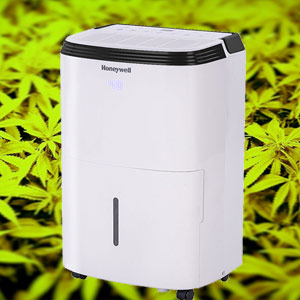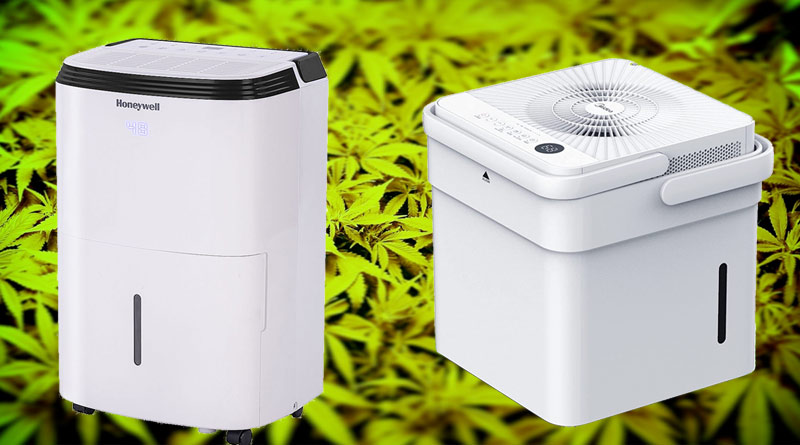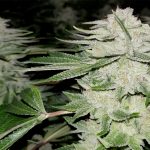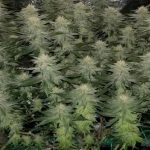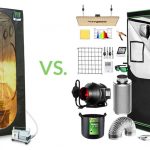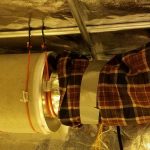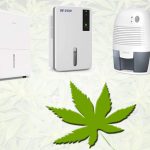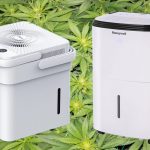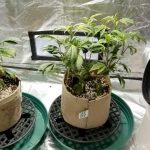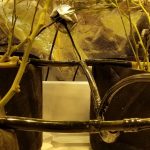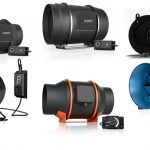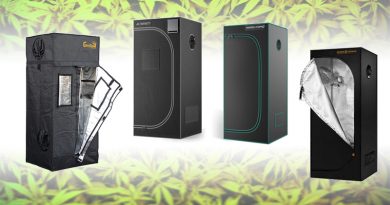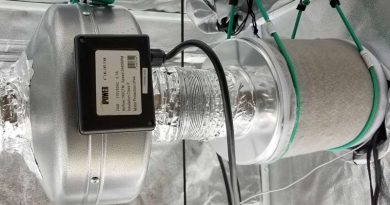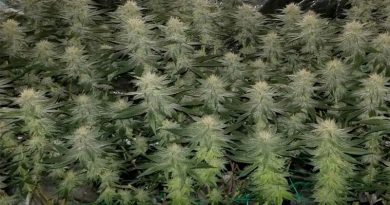Best dehumidifier for 3×3 grow tent setups
This post is intended for growers using fans to provide constant air exchange in a 3×3 grow tent or similarly sized grow room. Dehumidifiers for closed tent systems that are sealed to let you supplement carbon dioxide need to be much larger.
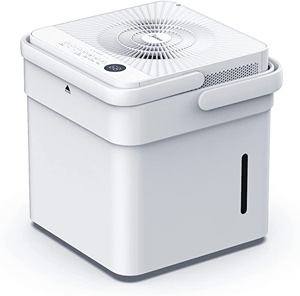
These are the target humidity levels to aim for when growing weed in your 3×3 tent:
- Vegetative stage: 40%-60%
- Flowering stage: 40%-50%
- Last few weeks or flowering stage: 40% or less
What size dehumidifier is needed for 3×3 grow tent?
What size dehumidifier you need for a 3×3 grow tent depends on the severity of your humidity issues in the surrounding room. There are two options on where to place a dehumidifier for 3×3 grow tent setups:
-
- Outside the tent (recommended): For most grow tent moisture problems or in damp climates, use a larger dehumidifier to dry out air in the “lung room” outside the tent. Dry air is introduced using tent’s intake fan.
- Inside the 3×3 tent: If your humidity problems are minor, a smaller dehumidifier can be placed directly inside the tent. This is very inefficient due to constant ventilation and it adds heat. But there are some reasons you might not want to do this except as a last resort which we’ll discuss below.
Dehumidifiers are rated on how many pints of water they remove a day. Weed plants transpire nearly all of the water you add to your plants back into the air, so you can size your dehumidifier accordingly. If you are adding two gallons (16 pints) of water daily to your plants in a 3×3 tent, dehumidifiers rated for 20 pints should offset this. If your tent is located in a damp area you need to factor that in to the pint rating and get a much larger unit.
Best dehumidifiers for 3×3 grow tent setups
These units are mostly in the 20-pint range, meant to offset daily plant transpiration in a room outside of the tent. For damper locations where ambient air exceeds your target tent humidity levels, you’ll need a more powerful unit.
Honeywell 20-pint dehumidifier ($200)
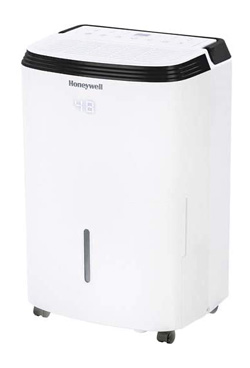
The 20-pint Honeywell dehumidifier is a great choice for small and mid-size rooms where you’re using a grow tent.
Their 20 pint unit rated for 1000 square feet and can remove 20-30 pints of water per day (about 2.5 gallons). This is usually enough in a 3×3 tent to offset the amount of water you’ll add each day that gets transpired into the air. So this unit is suitable for fairly dry grow spaces.
But if you’re growing weed in an overly damp area such as a basement you may want to opt for a higher powered version such as Honeywell’s 50 pint or even their 70 pint dehumidifier. This will do a better job contending with the additional moisture levels.
Honeywell’s 20-pint model has a digital humidistat control, a drain tube, a washable dust filter that doesn’t need to be replaced. It will auto-restart after a power outage which is a very important feature to consider when choosing a dehumidifier for 3×3 grow tent setups. It’s 10.5 x 13.2 x 20.1 inches and weighs 14 pounds.
They also make an upgraded 20 pint Honeywell with wifi that lets you adjust humidity and fan speed settings via a wifi app, which is great if you’re also using a wifi thermometer/hygrometer to monitor your grow tent remotely and need to make adjustments.
The Honeywell 20 pint model is a bit more reliable than some of the cheaper competitor brands in the 20-pint size range. It’s a best to use this model in small to midsize rooms that are moderately damp. But be warned – very damp conditions or rooms with multiple grow tents require a device with a bit more power to keep up.
hOmeLabs 1,500 SF dehumidifier ($220)
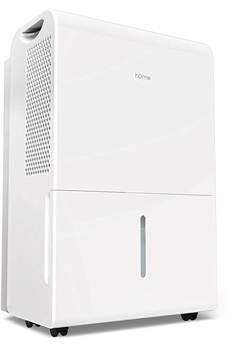
The hOmeLabs 1,500 SF Energy Star Dehumidifier is made for midsize rooms. It removes up to 22 pints of water per day and is Energy-Star certified.
It has a one gallon water tank that will shutoff once full. This means you’ll empty it twice a day, which sucks. A drain hose attachment is included, and it connects to a 5/8″ garden hose that isn’t provided. Use teflon tape for a sealed fit.
This dehumidifier is 15.2 x 10 x 19.7 inches and weighs 30.5 pounds.
hOmelab’s 1500 square foot model doesn’t have a pump. Pumps are available on the hOmelabs 50 pint model. This 4500 SF model is meant for large spaces, such as basements, and would run very inefficiently in smaller areas. They even offer a commercial-grade 140 pint dehumidifier for larger cannabis grows.
Whirlpool 40 Pint Portable Dehumidifier with pump ($230)
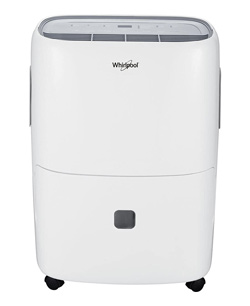
The Whirlpool 40 Pint Portable Dehumidifier has a built-in pump so it can reach an elevated drain or nearby window up to 16 feet higher than the unit. It is one of the cheaper dehumidifiers with a built-in pump.
It controls humidity levels for a 3000 square foot area. For smaller environments, consider the Whirlpool 30 pint model ($189). They also make a 40 pint model without a pump ($209).
The digital humidity settings range can be set from 35% to 80%. There are 3 fan speeds and auto-defrost. According to Consumer Reports, the model WHAD40PCW has a tank size of 14.9 pints (1.86 gallons).
This model will redstart automatically if your power goes out. It weighs 41.78 pounds and measures 12.01 x 15.04 x 25.2 inches.
Dehumidifiers for inside 3×3 grow tents
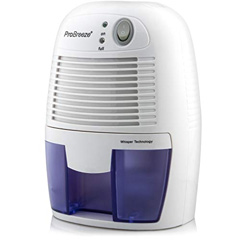
Placing a small dehumidifier inside a 3×3 tent seems like an obvious solution. Small space, small dehumidifier.
We learned this lesson the hard way after buying a compact unit for inside a grow tent. Tiny dehumidifiers don’t do remove enough moisture. Small reservoirs fill up quickly and they shut off until emptied.
Your tent’s exhaust fans should usually be exchanging grow tent air about 1x each minute. The small output of drier air from a tiny dehumidifier is quickly pulled out.
If ambient moisture levels rise in the room outside the tent while leaves transpire inside, small dehumidifiers can’t possibly keep up.
Recommendations for small dehumidifiers for 3×3 grow tents
Midea Cube 20 Pint Dehumidifier with Smart Wi-Fi ($179)
The Midea Cube 20 Pint Dehumidifier is great option for 3×3 grow tents, both inside and outside.
The Cube uses Wi-Fi so you can monitor and control it from your phone or via Alexa. App functions include a full water tank alert, preset water tank levels, real-time water and humidity levels, and a predictive bucket fill algorithm.
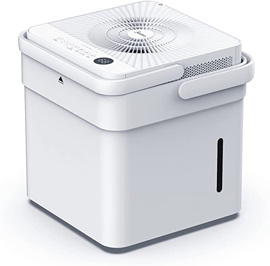
The Cube design is unique in that you can adjust the height. It has a no-bucket option that lets you remove the water tank and use the drain hose (included) to drain out of the tent to a floor drain.
In the nested setting it’s 13.5 x 13.5 x 13.39 inches, perfect when you need a powerful small dehumidifier inside a 3×3 grow tent under the plant canopy. When fully extended the bucket holds 3x more water. The air intake is multi-directional, a plus in grow tents.
Note that the Cube’s 20 pint model doesn’t include a pump, the drain is gravity only. Midea’s 50 pint Cube has a built-in pump but it’s meant for much larger rooms and way too big for inside a small tent.
The 20 pint Cube is ENERGY STAR rated and runs at 230 watts. The digital controls let you adjust humidity from 35% to 85%. It covers areas up to 1,500 Square feet.
Haier 20 Pint Dehumidifier ($139)
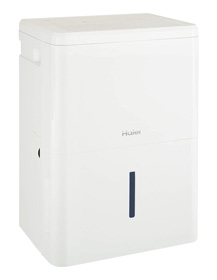
The Haier 20 Pint Dehumidifier model is the best cheap dehumidifier for 3×3 grow tent usage. It has enough power and a large enough tank to keep relative humidity (RH) levels down.
Haier’s Smart Dry feature compares the set humidity level with the actual humidity in the tent and automatically adjusts the fan speed accordingly. This is helpful to alter airflow if you’re seeing a large humidity variance in your light and dark cycles.
The front-loading bucket has a large capacity of 1.8 gallons, with a 10-second alarm when it gets full (although good luck hearing it over the sound of your inline fans). There is a continuous drain option, you can attach a hose about halfway up the left side. This unit 9.8 x 13.4 x 19.3 inches.
Note that the 20-pint Haier is meant for moderately damp locations. For wet environments, consider placing their much more powerful 50-pint model outside the tent.
Where to place dehumidifiers outside the tent
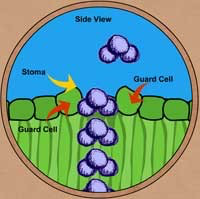
A 3×3 grow tent for weed plants is only 9 square feet. At 7 feet tall, it’s only 56 cubic feet. Not a lot of air volume. Your ventilation fan should be constantly replacing the air in your tent (ideally about 1x per minute). So it’s best to focus on lowering humidity in the larger volume of air outside of your tent.
Nearly all of the water you add to your plants makes its way back into the air due to transpiration. Small dehumidifiers don’t dry air fast enough to keep up.
Tent humidity problems are usually due to 2 things:
- Big, bushy weed plants transpire a lot of moisture that they pull up from the roots
- The ambient air outside of your tent is above your target RH, so the transpiration only makes it worse
Humidity levels can vary quite a bit inside 3×3 grow tents filled with bushy plants due to the light on/off light cycles. Due to the small volume of air inside, it’s much easier to maintain humidity outside the tent and then pull that drier air in. If your target tent humidity level is 50%, you will need to keep the air oustide of your tent a bit dryer than that to offset moisture added by your marijuana plants’ leaves.
In an emergency to fix an overly damp tent fast, point the blower fan on the dehumidifier directly into tent’s intake fan and crank it up, forcing really dry air in quickly. It’s useful if the dehumidifier is a bit underpowered for the space it’s in and can’t bring all of the air in you lung room down to the proper level. This approach can also be done with the airflow from an air conditioner unit for quick cooling.
Another word of warning about placing small dehumidifiers inside 3×3 grow tents
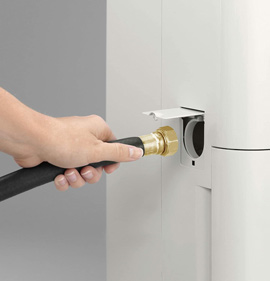
Be wary of online product descriptions for small dehumidifiers. Search “small dehumidifier” or “grow tent dehumidifier” on Amazon and you’ll see dozens of little units under $100.
It’s important to look at how much water they can remove per day, and how big the water tank is. Some have water tanks the size of a beer can.
We learned this lesson the hard way. We bought a mini dehumidifier, and the when that didn’t work we bought a larger but still way underpowered replacement. Currently we just use a 50-pint model outside of the tent and the tent humidity problems disappeared.
A small dehumidifier under $100 seem like they’d be perfect for a 3×3 tent. But they just can’t keep up keep up to transpiration from a bushy cannabis plant or two in a small space with constant air replacement.
Inside the tent: dehumidifier placement tips
Dehumidifiers should be placed low in a grow tent, but it’s best to elevate them slightly away from where water might spill.
If the unit’s fan blows out of the side don’t position the intake directly against a tent wall. If using a more powerful model inside a small tent, avoid having the dehumidifier’s airflow blow directly at weed plants.
Your tent’s ventilation system should be designed to intake fresh air from the bottom and exhaust warmer, humid air from the top. If it doesn’t, here’s how to correct it. Placing the dehumidfier low allows that dryer air to get pulled upward as the warmer humid air a the top of the tent is removed.
Prop the dehumidifier slightly if you need to raise the height to facilitate water drainage through a hose. But try to keep it low.
If you do place a dehumidifier inside your tent, make sure to cover any lights on the unit with black Gorilla tape when you are flowering weed plants.
Choosing the best dehumidifier features

When choosing a dehumidifier for your grow tent, there’s a few things to keep in mind.
- Dehumidifiers are rated by how many pints of water they are able to remove from the air.
- A 3×3 grow tent is only 9 square feet, a very small area.
- But if your air is already humid outside, transpiring leaves can make it humid quick.
- Small dehumidifiers have tiny reservoirs. Emptying buckets sucks.
- Larger models don’t fill up as fast. Or attach a drainage hose.
- A dehumidifier with a pump will let you reach elevated drains.
- A 3×3 grow tent dehumidifier with bluetooth connectivity lets you both monitor and control settings on an app. Perfect to identify swings in humidity levels throughout the day.
- Look for models with multiple fan speeds and settings for target humidity level.
- Some smaller models run continuously, while other can shut off when humidity reaches a set level.
Other ways to lower humidity in a 3×3 grow tent
Before you buy a dehumidifier there’s a few things you should try first to lower humidity in your 3×3 grow tent.
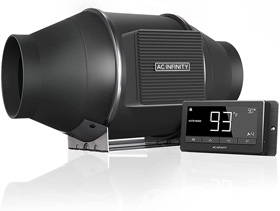
The first step is to set up your exhaust airflow properly. Increase your tent’s exhaust fan with a fan controller so that the air volume of your tent gets turned over at least once per minute.
For a 3x3x7 grow tent, that’s 56 cfm. Since you need to account for bends in ducting which reduce efficiency, run your fan higher than the target CFM. A 4 inch inline fan with a fan controller is perfect for this.
Another consideration is air intake. In a small tent such as a 3×3, during vegetation you can simply open the bottom tent flaps so air can enter and circulate up to the exhaust fan at the top of the tent.
But when you need to close those flaps for flowering, you create a vacuum. You have three options to introduce air:
-
- Passive: use a length of flexible ducting through an opening in the lower part of the tent.
- Active: sttach a low volume duct booster fan ($26) to flexible ducting.
- DIY lightproof grow tent intake box: attaches to your intake flaps. It’s a much bigger project.
Learn how to set up these options in our guide to grow tent ventilation setup, or see reviews to find the best fan for a grow tent. If you’re still having humidity issues, check out how to lower humidity in a grow tent.
For 3×3 grow tents usually proper air intake will restore ventilation to reduce humidity levels from transpiration. But for many growers depending on whether or tent location the air outside their tent is too moist to control tent moisture levels and a dehumidifier is the solution.
A tip for new marijuana growers: try to address grow tent humidity issues before the flowering phase begins. High humidity during mid and late flowering brings a big risk. You don’t want to watch your buds get moldy when they’re almost ready to go.
Need more info on picking the best humidifier for 3×3 grow tent setups? Check out our grow tent dehumidifier guide. For larger tents, check out our 4×4 grow tent dehumidifier guide.
If you’re a new grower and need to buy your 3×3 tent setup, find out how to select the best 3×3 grow tent kit.
